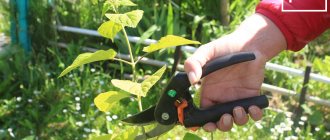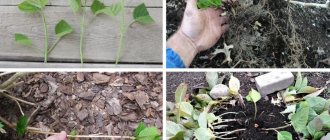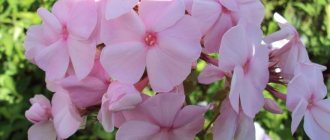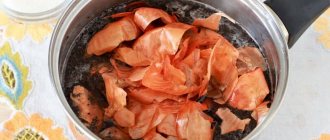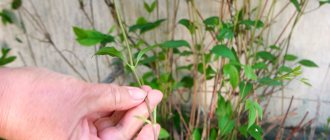Decorative barberry with glossy foliage in purple, lemon, and variegated shades is a favorite of landscape designers. An unpretentious shrub is indispensable for hedges, effective as a tapeworm, on an alpine hill, and will decorate a mixborder of conifers and perennials. To obtain uniform planting material while maintaining the characteristics of the mother plant, vegetative propagation of barberry is used; species forms can be grown from seeds. The effectiveness of a particular method depends on the characteristics of the variety, skills and patience of the gardener.
Picturesque thickets of barberry are distinguished by their decorativeness and enviable vitality
When can reproduction be carried out: features
The timing of barberry propagation depends on the chosen method. When cuttings, the procedure is carried out in early spring or, conversely, in the winter. Young branches take root well in greenhouse conditions.
Barberry Thunberg
Dividing the bush is done at the beginning of the season. When the buds begin to swell and the leaves begin to bloom. The leaves will not interfere when dividing the bush. This way you can select the desired piece.
Root shoots appear at the beginning of the season. It takes some of the nutrients from the soil and inhibits the development of the mother bush. It is recommended to remove shoots to make the barberry more luxuriant. But if there is a goal to propagate the plant, then the shoots are left until the end of the season. The procedure begins in the fall.
Propagation of barberry by seeds is a labor-intensive process. The grains are prepared in advance for several months. Layering is done simply. It is advisable at the beginning of the season so that by autumn the new bush can be transplanted to a new location.
It is important to know! The varietal identity is completely transmitted if barberry is propagated by cuttings or shoots.
Rules for breeding different species
It is known that decorative barberry is usually propagated by seeds or vegetatively. To breed any of the types and varieties of barberry, you need to carefully familiarize yourself with all methods of plant propagation. Having studied the characteristics of each species, it will immediately become clear what barberry needs. It is a mistake to believe that choosing the appropriate option is very simple, because each has its own disadvantages. If we talk about the cutting method, it is worth noting that rooting occurs very slowly. When sowing barberry seeds in open ground, a small germination rate is expected, the maximum figure can reach 40%. With all this, the varietal characteristics of the plant are lost. Dividing the bush can negatively affect the rhizome of barberry, and the root shoots are not suitable for all varietal varieties.
It is best to try each method to find one that is suitable for growing a particular barberry variety. So, for an ornamental shrub with red leaves called Thunberg barberry, the method of propagation by cuttings is perfect. The thing is that this type of shrub forms a large number of thin stems, which subsequently serve as suitable planting materials.
Particularly striking is the bright foliage, which is replete with various colors. It can be colored in various shades of yellow, red and green.
Beginner gardeners often make mistakes when growing barberry. The main mistake when propagating by seeds is their small quantity. For sowing, it is necessary to stock up three times more planting material than is needed for other plant varieties. This is due to poor seed germination.
The danger of spoiling a young seedling also arises during the process of digging up root shoots. After dividing the bush, the root system is damaged, and subsequently young plants can suffer for a long time due to the formation of new roots. This method is only suitable for adult plants. Barberry has the ability to reproduce in all existing ways. However, not all of them are suitable for growing certain varieties of shrubs. If you want to get a plant that has all the varietal properties, it is recommended to resort to the method of vegetative propagation.
To learn how to propagate barberry, watch the video.
Propagation by cuttings
It is easier to cut common barberry in summer than in autumn. Thunberg barberry is considered a special variety. It has beautiful flowers and large fruit ovaries. To reproduce, the bush must be no more than 10 years old. After this age, cuttings have difficulty rooting and growing barberry becomes more difficult. How to properly cut barberry?
How to propagate thuja - cuttings and transplantation
It is easy to grow cuttings of ornamental shrubs. The transplant process occurs according to the following algorithm:
- At the beginning of the season, the bush is inspected, young shoots 15-20 cm long are selected. Lignified branches that have 3-4 internodes are also suitable.
- Preparations are made at any time of the year. Planting is carried out mainly in early summer.
- The lower end of the branches is made oblique. This way it will absorb water faster and produce roots.
- If there are leaves, cut them in half.
- On the first day, leave the cuttings in water with the addition of a root formation stimulator.
- Next, the cuttings are transferred to the ground or left in water until the first roots appear.
- If the branches are planted in the ground, they are covered on top with a glass jar or plastic bottle. A greenhouse effect is created inside.
- You can immediately plant the cuttings in a greenhouse.
Additional Information! Without a root formation stimulator, barberry produces roots very slowly.
Cuttings of barberry in summer ensure better survival rate. Winter branches take root worse.
How does barberry reproduce in natural conditions?
Barberry is a large shrub that can grow up to 2 m in height. It is highly decorative all year round. It blooms with yellow flowers collected in clusters. The fruits are ruby in color and are often decorated with bare shoots even in winter. The foliage turns bright red in autumn.
Varieties have been developed in which the leaves have patterns, borders, or are colored in unusual shades.
If you give barberry freedom for several years, then, like rose hips, it will take over the entire adjacent territory with shoots. In addition, this bush reproduces well by self-sowing. But if your goal is to obtain cultivated seedlings that retain varietal qualities, then it is better to use reliable and proven agricultural propagation methods.
Thickets of barberry look very beautiful, but it is simply impossible to care for such a continuous mass of shoots with sharp thorns
Dividing the bush
Barberry Cobalt - variety description and care
How to properly propagate barberry by dividing the bush? The issue is easily resolved. New bushes quickly take root when:
- They dig up the mother bush.
- They move him to the shade.
- Using scissors, you need to divide the plant into 2 equal halves. At least 3 shoots should come from each daughter barberry.
- 2 holes are dug in the garden. The soil is mixed with fertilizers and well moistened.
- Bushes are planted in a new habitat.
- After 2 weeks, the plants will fully recover.
Barberry in autumn
This method is better for growing young bushes. Digging up a large mature shrub is difficult. During work, you can scratch yourself, break healthy branches and harm the plant.
Video description
About rust on plants is presented in the video:
Tracheomycosis wilt
One of the most common diseases of barberry, which is caused by various pathogens contained in the soil and on plant debris. By infecting the roots, the fungus prevents the penetration of food and the barberry, starting from the tops, turns yellow, turns brown and dries out. The cut shows inclusions of white-pink mycelium with fusarium and gray cobwebby with verticillium.
To combat these diseases, you should water the soil under barberry with phytosporin, alirin-B or gamair.
Air layering
Barberry Ottawa Superba - description and care
How does barberry propagate by layering and what is it? Everything is actually very simple. An adult shrub growing in the garden. Its branches hang straight to the ground. A couple of them remain in the ground. However, it cannot be cut off from the mother plant. The cuttings are kept in this form until the end of the season.
Sections of the branches will receive nutrition from the soil and from the plant at the same time. Therefore, the survival rate is high. Subsequent procedures and care for layering:
- By the end of summer, they check how well the layering has taken root. The roots should be palpable.
- The tops are cut off from the main bush so that at least 3-4 internodes remain in the new plant.
- It is necessary to plant new barberries in their own holes.
- While the shoots are taking root, they are periodically hilled up. The more land at the base, the better the process goes.
- Plantings are watered every week with 500 ml of water. You can’t overwater them so as not to wash away the soil near the trunk.
- Feeding is carried out at the same level with all barberries.
Barberry fruit
You should know! After rooting the cuttings, cut off the top. They leave the new bush next to the mother one to make it easier for it to adapt to the new type of nutrition.
Video description
More information about powdery mildew can be seen in the video:
Rust on barberry
The disease manifests itself as bright orange spots on the leaf blades on the outside. On the inside, fungal spores appear in the form of yellow dots. The fight against the disease should begin immediately. To do this, tear off all the affected leaves and burn them, treat the dormant buds with fungicides. Rust develops more often with a lack of potassium and phosphorus fertilizers, on weakened plants.
Seeds
How exactly does barberry propagate from red seeds? Similar to other varieties. At the end of the season, several branches with fruits are left until they are fully ripe. By mid-September, seed pods are formed. Collect them and dry them well. Seed germination lasts for 2 years.
Note! Seed propagation is full of surprises. There is no guarantee that the new plant will inherit all the characteristics of the mother shrub.
Seeds are planted in winter or early summer. Seed germination is higher if you plant fresh seeds for the winter. The process is carried out step by step:
- Prepare in advance a bed 20 cm high from nutritious and dry soil.
- Dig holes. Make a distance of 15-20 cm between them, and 30 cm between the rows.
- A day before planting, soak the grains in water with potassium permanganate.
- The next day, place one seed in each hole.
- Seal the holes with overripe humus.
- Cover for the winter with agrofibre or spandbond.
In spring the first shoots will appear. Not all seeds will germinate quickly; some will appear above the ground only at the beginning of summer. When there are 3-4 leaves on the stem, new bushes are planted in a permanent place. The plants are well watered beforehand to ensure root turgor.
When planting seeds in summer, the grains are first stratified. In March, they are laid out in wet rags, covered with cellophane and sent to the top shelf of the refrigerator. Sprout at home on a wet cloth. Sowing is carried out in early May. By the end of the season, sprouts appear. The germination rate of winter sowing is 20% higher than summer sowing. New bushes can stand for some time, and then die if strong shoots grow next to them.
Decorative variety of barberry
Video description
How to deal with plant fusarium is described in the video:
Drying of shoots
The fungal disease manifests itself as necrosis of the bark in individual brown areas that begin to dry out. Control measures include removing dry branches and spraying with preparations containing copper.
Barberry aphid
Small sucking insects, 2 mm in size, yellow-red in color, live on the underside of barberry leaf blades. The leaves gradually dry out and fall off. To combat the pest, fitoverm, spark, actara, and inta-vir are used.
For prevention you should:
- avoid drying out the soil;
- apply mineral fertilizers;
- carry out sanitary pruning.
And also inspect the bushes and take action if diseases or pests are detected.
Root shoots
It is customary to remove the root shoots as they interfere with the normal nutrition of the mother barberry. But if you want to propagate the plant, then shoots are perfect. They inherit all the characteristics of the main bush.
Throughout the season, children are cared for in the same way as adult plants. Closer to September, a place for transfer is being prepared. Fertilize the soil with mineral additives. They dig up the baby and plant it in a new place.
Interesting! If barberry produces new babies, it means it is healthy, full of strength, ready for reproduction and active flowering.
The shoots are true bushes. That’s why their survival rate is high. In the first year, the plant is actively fertilized, watered and covered for the winter. This way it will bloom and bear fruit more quickly. Adding a growth stimulator helps the barberry root.
Diseases and pests
Barberry is very hardy and relatively resistant to various diseases. Problems can be caused by fungal pathogens that develop mainly after heavy, prolonged rainfall. Excessive humidity and cold can cause diseases:
- powdery mildew;
- barberry leaf spot.
Spot appears as brown spots on leaves and dying shoots.
To prevent fungal diseases, you need to be careful when watering, watering the bush directly around the trunk. Immediately after the first symptoms of the disease are detected, the bush is sprayed with fungicides intended to protect deciduous shrubs.
Barberry can be damaged by pests:
- mealybugs (felt bugs);
- scale insects feeding on the underside of small leaves;
- barberry sawfly (Arge berberidis Schrank) - its larvae eat leaves.
Photo. Sawfly Arge berberidis Schrank
Pests can make damaged shoots more susceptible to fungal growth.
Common Mistakes
It is not difficult to propagate barberry. However, beginners make mistakes. The most common of them:
- Incorrectly selected cuttings. The length and number of internodes is strictly limited. A branch that is too long will not be able to fully feed, and a short one does not always take root.
- The greenhouse effect has a beneficial effect on survival rate. But it’s worth ventilating the greenhouse once a day. Sprouts need fresh air.
- Too much fertilizer in new soil can burn the roots of the shoot. Add additives strictly according to the instructions.
- It is not recommended to use fresh manure to feed new plants. It contains a large amount of nitrogen, which causes burns.
- Abundant watering is good. But everything should be in moderation. If a lot of moisture accumulates in the ground, the roots and lower part of the cutting will rot.
- When selecting cuttings, they are cut only with a disinfected tool. You can't break off branches. The cut should be oblique, not straight.
- Be sure to use a root former, so new roots will not keep you waiting.
- Cover young bushes for the winter; winter hardiness is not fully evident until the age of three.
Yellow barberry
Thunberg's barberry and its propagation by cuttings are almost no different from other varieties. You need to follow the rules and useful tips and the new shrubs will definitely take root.
Barberry is a wonderful plant that delights gardeners not only with its flowers, but also with its berries. They are used for completely different purposes: they cook compotes, preserves, bake pies and prepare syrups. Shrubs are great for landscape design. They are planted along the fence (it turns out to be a beautiful green hedge).
Beneficial features
All parts of the plant contain vitamins, microelements, organic acids, tannins and pectin. Berries contribute to:
strengthening the walls of blood vessels;
normalization of pressure;
outflow of bile;
blood purification.
In addition, they compensate for the lack of vitamins, increase immunity, and have a diuretic and diaphoretic effect.
Healthy berries Source static.ogorodniki.com

